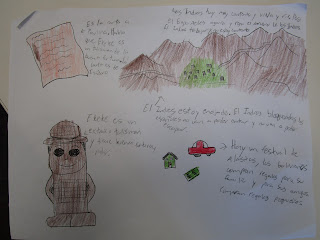Because it was the last day before a vacation, the kids were very, very distracted. I tried a different order of events each class period until I got it right. 8th period was the best, so you get to see 8th period's order of things. First, we briefly reviewed Chapter 11 and some of the previous chapters with circling questions. I wanted it to be fresh in their minds before I had them evaluate the novel and communicate what they learned about Bolivia.
Next, they filled out said evaluations, answering the following questions. I'll post their answers once I sort through them.
1. What are some things you learned about Bolivian culture?
2. What was the most interesting part of the book to you?
3. What was the most difficult part about reading this book?
4. What do you wish we would learn about next?
5. Any other comments about the novel?
As our last activity of the day, students created their own Ekekos and decorated them with gifts for their friends and family. Using the template from the teacher's guide, students colored an Ekeko and drew miniature items that represented what they would like to give to their families. The problem was, they couldn't remember multi-step directions today, so I broke it up into steps. Step one: draw 3 or more mini-gifts you would give your family or friends (5 min). Step two: label the gifts in Spanish (5 min). Step three: color and decorate (10 min).
Last weekend John Oliver had a funny segment about the Bolivian zebras, the young people who wear zebra costumes and help teach citizens about traffic laws. It is a really positive segment that doesn't make fun of Bolivian culture or swear at all, so I decided to show it in class. There IS one mildly inappropriate moment around 2:40, so I downloaded the video and clipped it in Movie Maker before showing it to my middle-schoolers. We watched this five-minute video while the students finished up coloring their Ekekos.
Last, students presented their Ekekos to each other, using the phrase "Me gustaria ____________ para ________." I don't have art-loving kids this year, so a lot of them were honestly pretty terrible, but the writing and speaking part was fine, and it was a fun activity to keep them engaged the day before a break. Here's a sampling of some of the better ones:









